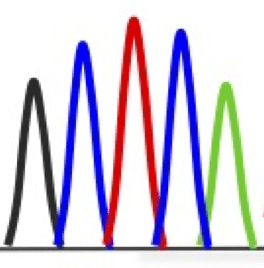Chediak-Higashi Syndrome
Gene: LYST
Transmission: Autosomal, recessive
For an autosomal recessive genetic disease an animal must have two copies of the mutation in question to be at risk of developing the disease. Both parents of an affected animal must be carriers of at least one copy of the mutation. Animals that have only one copy of the mutation are not at risk of developing the disease but are carrier animals that can pass the mutation on to future generations.
Mutation: Tandem duplication within LYST gene: 20 kb duplication including exons 30 to 38.
Breed: Persian
Medical system: Cutaneous, ocular, blood, immune, neurologic
Age of onset of symptoms: From birth.
Chediak-Higashi Syndrome (CHS) is a rare genetic disorder seen in a number of animal species that is characterized mainly by oculo-cutaneous albinism. In cats, CHS was identified within an isolated pedigree of Persians. Affected cats display a characteristic light-blue smoky coat colour and light-yellow eye pigmentation. The syndrome is caused by a mutation in the LYST gene, which codes for a protein involved in the intracellular trafficking of lysosomes and related organelles including melanosomes, platelet granules, neutrophil granules as well as other cellular granules. Cats with CHS can also suffer from coagulation disorders, increased susceptibility to infection and photophobia. In some cases, neurological disorders such as coordination problems or muscle weakness may be present. The defect in melanosome function explains the characteristic hypopigmentation observed, and the diagnosis can be substantiated by observing abnormally large granules within certain cells such as melanocytes, platelets, leukocytes and even hair.
Feline CHS arose originally from a de-novo mutation within an isolated pedigree of Persian cats. University based research colonies were generated as models to study the disease in cats, but these colonies were eventually disbanded. The disease model has recently been resurrected using reproductive technologies. It can be concluded that CHS in cats is a genetic disease of academic and historical interest but is not a disease of concern for Persian breeders.
References:
OMIA link: [0185-9685]
Haginoya S, Thomovsky EJ, Johnson PA, Brooks AC. (2023) Clinical assessment of primary hemostasis: A review. Top Companion Anim Med 56-57:S1938-9736(23)00058-2:100818. [pm/37673175]
Buckley RM, Grahn RA, Gandolfi B, et al. (2020) Assisted reproduction mediated resurrection of a feline model for Chediak-Higashi syndrome caused by a large duplication in LYST. Sci Rep 10:64. [pm/31919397]
Creel DJ, Conlee JW, Collier LL, Prieur DJ. (1994) Auditory brainstem responses in cats with Chediak-Higashi syndrome Acta Oto – Laryngologica 114:373-375. [pm/7976308]
Krammer JW, Davis WC, Prieur DL. (1977) The Chediak-Higashi syndrome of cats Laboratory Investigation 36:554-562. [pm/865082]
Contributed by: Annabelle Chaput and Xavia Boucher Ramos, Class of 2029, Faculté de médecine vétérinaire, Université de Montréal. (Translation DWS).

